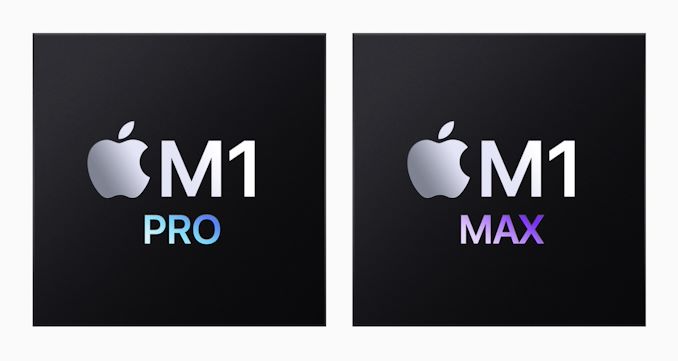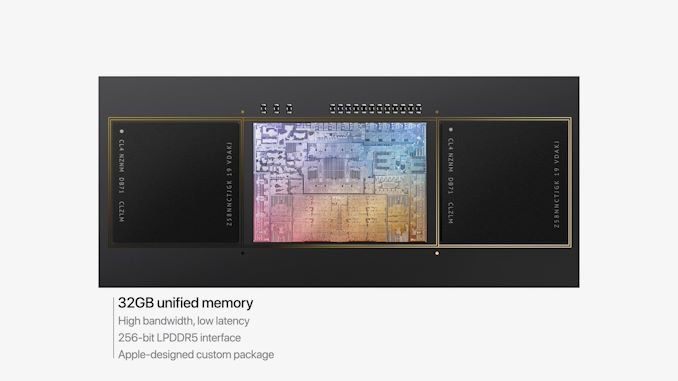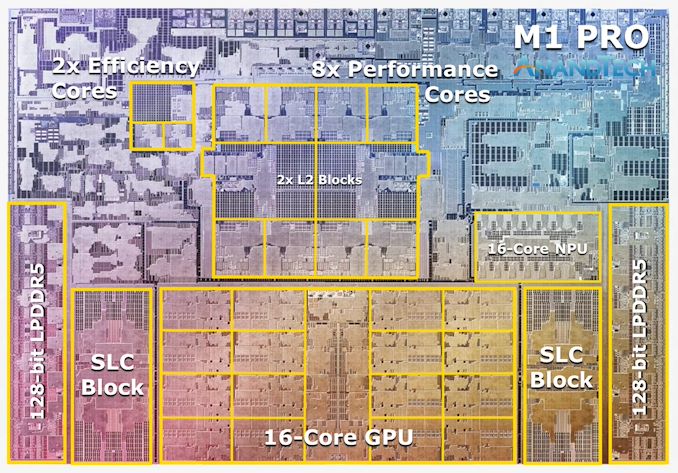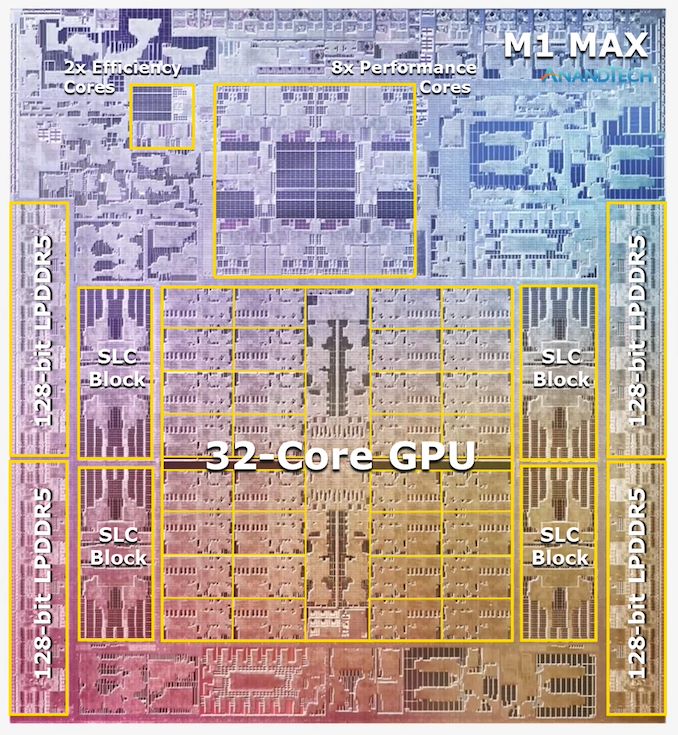Apple's M1 Pro, M1 Max SoCs Investigated: New Performance and Efficiency Heights
by Andrei Frumusanu on October 25, 2021 9:00 AM EST- Posted in
- Laptops
- Apple
- MacBook
- Apple M1 Pro
- Apple M1 Max

Last week, Apple had unveiled their new generation MacBook Pro laptop series, a new range of flagship devices that bring with them significant updates to the company’s professional and power-user oriented user-base. The new devices particularly differentiate themselves in that they’re now powered by two new additional entries in Apple’s own silicon line-up, the M1 Pro and the M1 Max. We’ve covered the initial reveal in last week’s overview article of the two new chips, and today we’re getting the first glimpses of the performance we’re expected to see off the new silicon.
The M1 Pro: 10-core CPU, 16-core GPU, 33.7bn Transistors
Starting off with the M1 Pro, the smaller sibling of the two, the design appears to be a new implementation of the first generation M1 chip, but this time designed from the ground up to scale up larger and to more performance. The M1 Pro in our view is the more interesting of the two designs, as it offers mostly everything that power users will deem generationally important in terms of upgrades.
At the heart of the SoC we find a new 10-core CPU setup, in a 8+2 configuration, with there being 8 performance Firestorm cores and 2 efficiency Icestorm cores. We had indicated in our initial coverage that it appears that Apple’s new M1 Pro and Max chips is using a similar, if not the same generation CPU IP as on the M1, rather than updating things to the newer generation cores that are being used in the A15. We seemingly can confirm this, as we’re seeing no apparent changes in the cores compared to what we’ve discovered on the M1 chips.
The CPU cores clock up to 3228MHz peak, however vary in frequency depending on how many cores are active within a cluster, clocking down to 3132 at 2, and 3036 MHz at 3 and 4 cores active. I say “per cluster”, because the 8 performance cores in the M1 Pro and M1 Max are indeed consisting of two 4-core clusters, both with their own 12MB L2 caches, and each being able to clock their CPUs independently from each other, so it’s actually possible to have four active cores in one cluster at 3036MHz and one active core in the other cluster running at 3.23GHz.
The two E-cores in the system clock at up to 2064MHz, and as opposed to the M1, there’s only two of them this time around, however, Apple still gives them their full 4MB of L2 cache, same as on the M1 and A-derivative chips.
One large feature of both chips is their much-increased memory bandwidth and interfaces – the M1 Pro features 256-bit LPDDR5 memory at 6400MT/s speeds, corresponding to 204GB/s bandwidth. This is significantly higher than the M1 at 68GB/s, and also generally higher than competitor laptop platforms which still rely on 128-bit interfaces.
We’ve been able to identify the “SLC”, or system level cache as we call it, to be falling in at 24MB for the M1 Pro, and 48MB on the M1 Max, a bit smaller than what we initially speculated, but makes sense given the SRAM die area – representing a 50% increase over the per-block SLC on the M1.
The M1 Max: A 32-Core GPU Monstrosity at 57bn Transistors
Above the M1 Pro we have Apple’s second new M1 chip, the M1 Max. The M1 Max is essentially identical to the M1 Pro in terms of architecture and in many of its functional blocks – but what sets the Max apart is that Apple has equipped it with much larger GPU and media encode/decode complexes. Overall, Apple has doubled the number of GPU cores and media blocks, giving the M1 Max virtually twice the GPU and media performance.
The GPU and memory interfaces of the chip are by far the most differentiated aspects of the chip, instead of a 16-core GPU, Apple doubles things up to a 32-core unit. On the M1 Max which we tested for today, the GPU is running at up to 1296MHz - quite fast for what we consider mobile IP, but still significantly slower than what we’ve seen from the conventional PC and console space where GPUs now can run up to around 2.5GHz.
Apple also doubles up on the memory interfaces, using a whopping 512-bit wide LPDDR5 memory subsystem – unheard of in an SoC and even rare amongst historical discrete GPU designs. This gives the chip a massive 408GB/s of bandwidth – how this bandwidth is accessible to the various IP blocks on the chip is one of the things we’ll be investigating today.
The memory controller caches are at 48MB in this chip, allowing for theoretically amplified memory bandwidth for various SoC blocks as well as reducing off-chip DRAM traffic, thus also reducing power and energy usage of the chip.
Apple’s die shot of the M1 Max was a bit weird initially in that we weren’t sure if it actually represents physical reality – especially on the bottom part of the chip we had noted that there appears to be a doubled up NPU – something Apple doesn’t officially disclose. A doubled up media engine makes sense as that’s part of the features of the chip, however until we can get a third-party die shot to confirm that this is indeed how the chip looks like, we’ll refrain from speculating further in this regard.














493 Comments
View All Comments
valuearb - Tuesday, October 26, 2021 - link
Intels also vulnerable in servers to graviton, which has been growing at massive rates. ARM doesn’t need to have Apple Silicon level performance to win in servers if it’s cheaper and cooler.Hifihedgehog - Monday, October 25, 2021 - link
Where is Cinebench R23? Show more benchmarks!neural42 - Monday, October 25, 2021 - link
If you check cpu-monkey, there are some benchmarks there. Another option is if you buy one of the computers you can benchmark it and see if it will work for your needs. If you don't like the results, return the computer and stick with what you have.Silver5urfer - Tuesday, October 26, 2021 - link
SPEC Is all that matters. And real life encode decode also doesn't matter. Have to rely on Dave2D and other Youtubers lol.OreoCookie - Tuesday, October 26, 2021 - link
The purpose of this article was a low-level review of the M1 Max SoC's CPUs and GPU. SPEC is a widely accepted cross-platform, low-level benchmark where different benchmarks push different subsystems. This is complementary to real-world reviews where the gains are much more subtle. I remember seeing that with the M1 reviews where some testers did not see gains, because they were using the “wrong” codec in their workflow that wasn't hardware accelerated.Would I like to see similar low-level benchmarks for the NPU (i. e. the ML accelerator)? Yes. But testing that is much more difficult. Those are usually tied to platform-specific APIs. And even if you can run the same workload on x86 on the CPU cores, it isn't clear how much you'd learn from that — other than that dedicated custom hardware will be much faster and much more efficient.
DittyDan - Monday, October 25, 2021 - link
there appears to be something more at the bottom edge of the Max version of the chip vs the Pro just under the GPU logic. Is this dead space from something that was pulled or is there something more? I was thinking it was part of the FaceID which I guess was pulled or will show up in the next versions of these systems (2022 model)Tomatotech - Monday, October 25, 2021 - link
Noone knows yet if these die shots are actual die shots or just photoshopped PR images. AnandTech said they will wait for third party die shots before commenting further on what's visible in the die shots.mkppo - Monday, October 25, 2021 - link
So the M1 Max has triple the transistor count compared to a 5950x. Even if we add a RTX 3090 into the mix, it still has about 10 billion extra transistors. So yeah the performance is impressive but it's not like they've created a monster out of thin air - a lot of transistors are dedicated towards the silicon to make it wider and clocked lower to keep power in check. Impressive, but I know what i'd rather get if given a choice.valuearb - Tuesday, October 26, 2021 - link
If Intel could build at this transistor count they would, but they can’t as their CPUs would melt.Ppietra - Tuesday, October 26, 2021 - link
It’s an SoC, it’s more than a CPU+GPU.